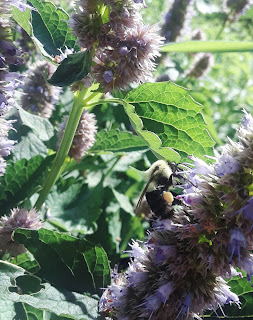An Array of Pollinators
A greater diversity of insects contribute to the act of pollination than one might expect. Bees, likely the most conspicuous of all, serve as agents of growth for most of the flowering crops found around the world. Yet while foraging for nectar or prey, a significant number of other insects inadvertently help to move pollen between flowers as well. In fact, nearly 200,000 such species of insects and other arthropods exist worldwide. Perhaps a few local examples might inspire a sense of awe for these powerful pollinators.
On a few occasions I have caught a glimpse of a butterfly feeding on nectar with its long and delicate proboscis and have thought that surely butterfly species contribute to pollination. But I know that butterflies can't be the only pollinators for me to observe atop a flowering plant in Cable. Likely the other visitors to my garden, like moths or even beetles, may take part in this activity as well. Impatiently stuck in the dead of winter, I turn to our entomology collection to explore the pollinators of our area.
 |
| A bumble bee can collect large amounts of pollen by sticking the grains to a smooth spot on its hind legs. When full, a "pollen basket" becomes noticeable to even the casual observer. |
On a few occasions I have caught a glimpse of a butterfly feeding on nectar with its long and delicate proboscis and have thought that surely butterfly species contribute to pollination. But I know that butterflies can't be the only pollinators for me to observe atop a flowering plant in Cable. Likely the other visitors to my garden, like moths or even beetles, may take part in this activity as well. Impatiently stuck in the dead of winter, I turn to our entomology collection to explore the pollinators of our area.
An entomology collection holds numerous specimens of species which may or may not actively transport pollen. All species in an entomology collection, however, are indeed insects. The word "entomology" itself refers to the study of insects. The base of this word is derived from the Greek entomon, meaning divided into segments, and some time later the Latin use of insectum emerged from that.
Insects have fascinated humans throughout history--from the deeply embedded practices of domesticating bees for honey, to cultural aversions towards insect pests that have plagued agricultural fields around the world. Despite our fascination, insect collecting as a scientific endeavor did not develop much until the early 1500's. The practice of organizing insects into meaningful categories, such as the taxonomic arrangement found in an entomology collection, really only took hold beginning in the 1700's. Today, the world's insect collections have grown to enormous, valuable resources.
Even though our entomology collection couldn't possibly rival that of the Smithsonian, our humble 700 pinned insects still provide ample inspiration. When field observations aren't possible, I can squint at one of our pinned green bottle flies and imagine how its minuscule hairs transported pollen between the skunk cabbage flowers which supplied the fly with tasty nectar. I may likewise simply wish to view the beautiful patterning of an ornate tiger moth, and marvel at the thought that I would have to venture out in the darkness of night to observe it reaching for nectar with a delicate tongue. For the time being, I'm content with simply building anticipation for live observations on warmer days.
Insects have fascinated humans throughout history--from the deeply embedded practices of domesticating bees for honey, to cultural aversions towards insect pests that have plagued agricultural fields around the world. Despite our fascination, insect collecting as a scientific endeavor did not develop much until the early 1500's. The practice of organizing insects into meaningful categories, such as the taxonomic arrangement found in an entomology collection, really only took hold beginning in the 1700's. Today, the world's insect collections have grown to enormous, valuable resources.
 |
| To give extensive insect collections a sense of order, each specimen is grouped with its respective taxonomic Family. |
Even though our entomology collection couldn't possibly rival that of the Smithsonian, our humble 700 pinned insects still provide ample inspiration. When field observations aren't possible, I can squint at one of our pinned green bottle flies and imagine how its minuscule hairs transported pollen between the skunk cabbage flowers which supplied the fly with tasty nectar. I may likewise simply wish to view the beautiful patterning of an ornate tiger moth, and marvel at the thought that I would have to venture out in the darkness of night to observe it reaching for nectar with a delicate tongue. For the time being, I'm content with simply building anticipation for live observations on warmer days.
 |
| Above, a bottle fly, also known as a blow fly, has small body hairs which collect pollen. An ornate tiger moth, below, may pick up pollen on its tongue or legs. |

